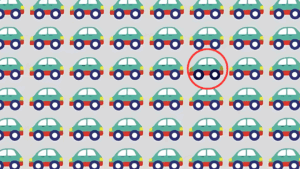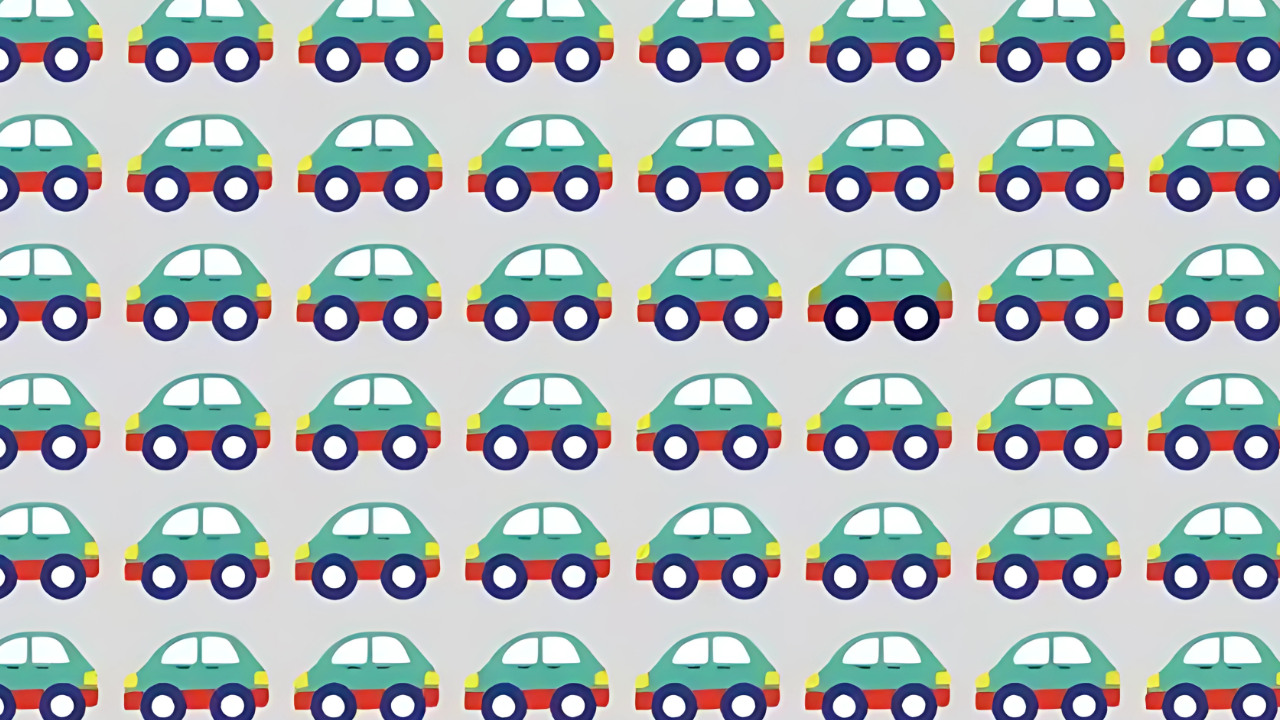Optical illusions have long fascinated people, blending entertainment with cognitive challenges that test perception, focus, and mental agility. The latest viral sensation, the “Fleet of Green Cars” optical illusion, has captured attention across platforms like IndiaTimes and social media, challenging even those with high IQs to spot the odd one out in a grid of seemingly identical green cars. This brain teaser, with its vibrant visuals and deceptive simplicity, pushes your observational skills to the limit, requiring you to identify a single car with a subtle difference in just 10 seconds. In this 1500-word article, we explore the mechanics of this illusion, why it’s so tricky, its cognitive benefits, tips to master it, and how it compares to other popular optical illusions, complete with a table for context.
Understanding the Green Cars Optical Illusion
The “Fleet of Green Cars” illusion presents a grid, typically 6×5 or 5×5, filled with images of green cars that appear identical at first glance. Each car is a bright green sedan with similar features—headlights, wheels, and body shape—arranged in a uniform pattern. Hidden among them is one car that differs in a subtle way, such as a slightly different wheel design, a missing headlight, or a variation in the car’s outline. The challenge is to spot this anomaly within a 10-second time limit, a task that tests your visual acuity and ability to process details under pressure.
This illusion leverages the brain’s tendency to group similar objects, a process known as perceptual grouping, which makes it hard to notice small discrepancies. The uniform green color and repetitive car shapes create a visual overload, forcing your brain to work overtime to detect the odd one out. The time constraint adds an extra layer of difficulty, as it limits your ability to scan methodically, making the puzzle both engaging and maddeningly elusive.
Why This Illusion Challenges Even High IQs
Optical illusions like the green cars challenge exploit how the brain processes visual information. The human brain is designed to recognize patterns and make quick assumptions to navigate complex environments. In this case, the uniformity of the green cars tricks the brain into assuming all are identical, a phenomenon called “visual masking.” This makes spotting the odd car difficult, as your brain glosses over subtle differences to focus on the overall pattern.
The challenge engages multiple brain regions, including the visual cortex, which processes raw visual data, and the prefrontal cortex, which handles decision-making and attention. The 10-second time limit increases cognitive load, forcing you to balance speed and accuracy. High-IQ individuals often excel at pattern recognition and rapid problem-solving, but even they can struggle with this illusion due to its reliance on fine visual discrimination. The pressure to perform quickly can lead to “attentional blink,” where the brain momentarily overlooks key details, adding to the challenge.
Cognitive Benefits of Optical Illusions
Solving optical illusions like the green cars challenge offers more than just a fun distraction. Research highlights several cognitive benefits:
-
Enhanced Visual Perception: Regularly engaging with illusions sharpens your ability to detect subtle differences, improving skills like proofreading or quality control.
-
Improved Focus and Attention: The time pressure trains your brain to concentrate and filter out distractions, enhancing sustained attention.
-
Boosted Problem-Solving Skills: Identifying the odd one out requires analytical thinking and creative approaches, fostering cognitive flexibility.
-
Stress Reduction: Solving puzzles can be meditative, diverting your mind from daily stressors and promoting relaxation.
-
Mental Agility: Switching perspectives to spot anomalies enhances your ability to adapt to new challenges, a key trait of high-IQ individuals.
Successfully spotting the odd car in under 10 seconds is often cited as a marker of superior visual processing and high cognitive ability. Even if you don’t succeed, the process of trying strengthens neural pathways, making future challenges easier.
Strategies to Spot the Odd One Out
Mastering the green cars illusion requires a blend of strategy and practice. Here are five tips to improve your performance:
-
Break the Grid into Sections: Divide the grid into smaller parts, such as quadrants or rows, to make scanning more manageable. Focus on one section at a time to avoid visual overload.
-
Look for Specific Details: Pay attention to elements like wheels, headlights, or the car’s outline. The odd car might have a missing feature, a different size, or a rotated element.
-
Use Peripheral Vision: Instead of staring at one car, let your eyes sweep across the grid to catch anomalies that pop out in your peripheral vision.
-
Take a Quick Break: If you’re stuck, blink or look away briefly to reset your focus. Fresh eyes can help you spot what you missed.
-
Practice with Similar Puzzles: Engage with other “odd one out” illusions to train your brain to detect differences faster. Over time, your visual discrimination will improve.
For those struggling, the odd car is often located in the third row, fourth column, with a subtle difference like a missing headlight or altered wheel spokes. Check solution images on platforms like IndiaTimes for confirmation.
Comparing the Green Cars Illusion to Other Puzzles
The green cars illusion is part of a family of “odd one out” optical illusions, each designed to test specific cognitive skills. Below is a table comparing it to other popular brain teasers:
|
Puzzle |
Description |
Time Limit |
Key Skill Tested |
Difficulty |
|---|---|---|---|---|
|
Green Cars Challenge |
Spot one different green car in a 5×5 or 6×5 grid of identical cars. |
10 seconds |
Visual discrimination |
Moderate |
|
Red Cards Illusion |
Find one unique red card among a grid of similar cards. |
10 seconds |
Pattern recognition |
Moderate |
|
Hidden Number (e.g., 94 among 49s) |
Identify a number like 94 in a grid of 49s. |
7 seconds |
Rapid pattern detection |
Hard |
|
Hidden Animal (e.g., Cat among Dogs) |
Spot a hidden animal, like a cat, in a group of similar animals. |
12 seconds |
Attention to detail |
Hard |
|
Chess Piece Illusion |
Find one different chess piece among similar pieces. |
5 seconds |
Quick decision-making |
Very Hard |
The green cars challenge stands out for its vibrant visuals and moderate difficulty, making it accessible yet engaging for a wide audience.
The Viral Appeal of Optical Illusions
Optical illusions have exploded in popularity, particularly on social media platforms like X, where users share their solving times and challenge friends. The green cars illusion, with its bright visuals and quick 10-second format, is perfect for viral engagement. It requires no special tools—just a sharp eye and a moment of focus—making it universally accessible. The competitive element, where users boast about spotting the odd car in record time, fosters a sense of community and friendly rivalry.
Beyond entertainment, these puzzles tap into our fascination with how the mind works. They reveal the quirks of human perception, showing how easily our brains can be fooled by clever design. This blend of fun, challenge, and insight keeps optical illusions like the green cars challenge trending across platforms.
The Science Behind the Illusion
The green cars illusion exploits several principles of visual perception. The Gestalt principle of similarity causes the brain to group the cars as a single unit, masking the odd one out. The uniform green color reduces contrast, making differences harder to spot. Additionally, the time pressure triggers the brain’s “inhibition of return,” where previously scanned areas are less likely to be revisited, increasing the chance of missing the anomaly.
Neuroscientists note that such illusions activate the brain’s dorsal stream, responsible for spatial awareness, and the ventral stream, which processes object identity. The interplay between these systems, combined with the prefrontal cortex’s role in decision-making, makes solving the illusion a complex cognitive task. High-IQ individuals may excel due to their ability to quickly integrate these processes, but even they can be stumped by the illusion’s clever design.
Cultural and Educational Impact
Optical illusions like the green cars challenge have found a place in education and cognitive training. Teachers use them to engage students in critical thinking exercises, while psychologists employ them to study perception and attention. In corporate settings, such puzzles are used in team-building activities to foster collaboration and problem-solving. The universal appeal of these challenges transcends age and culture, making them a powerful tool for learning and entertainment.
In Australia, where visual puzzles are popular, the green cars illusion has resonated due to its car-themed design, aligning with the country’s love for automotive culture. Its accessibility makes it a favorite in classrooms, workplaces, and social gatherings, where participants compete to prove their observational prowess.
The Future of Optical Illusions
As technology advances, optical illusions are evolving. Augmented reality (AR) and virtual reality (VR) versions of puzzles like the green cars challenge could add dynamic elements, such as moving cars or changing colors, increasing complexity. Online platforms are also integrating AI to generate personalized illusions, tailoring difficulty to individual skill levels. These innovations promise to keep optical illusions relevant, offering new ways to challenge and entertain.
For now, the green cars illusion remains a classic, testing the limits of human visual perception and cognitive agility. Whether you solve it in 10 seconds or take longer to find the odd car, the process sharpens your mind and provides a satisfying mental workout.

Looking Forward
The “Fleet of Green Cars” optical illusion is more than a viral puzzle—it’s a test of perception, focus, and mental agility that captivates and challenges. Its deceptive simplicity, vibrant design, and 10-second time limit make it a perfect brain teaser for all ages. By engaging with this illusion, you not only enjoy a moment of fun but also enhance your cognitive skills, from observation to problem-solving. Whether you spot the odd car instantly or need a few tries, the journey is a rewarding exploration of how your brain sees the world. So, take the challenge, scan that grid, and see if you can claim the title of a high-IQ puzzle master!

